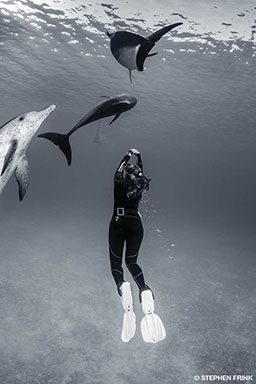There is an appeal to being able to venture underwater using a minimum of equipment. The desire to explore unencumbered has led to increasing interest in breath-hold (apnea) diving, also called freediving. There are, however, potential hazards associated with this activity that should be reviewed. Understanding the basic components of the human respiratory drive can help reduce the potential for life-threatening or life-ending complications.
Human respiration is primarily an autonomic function, requiring no conscious effort. We can exercise control over our breathing, but only for short periods. Most of us, at some time in our lives, have attempted to determine how long we can hold our breath. Regardless of the length of time or circumstance, there is a point at which the urge to breathe is overpowering, and we end the breath-hold. With practice and observation we may have discovered techniques for increasing our breath-hold time.
One common technique is taking multiple breaths in rapid succession just before holding the last inspiration. This is known as hyperventilation: effectively, ventilation in excess of metabolic need. Some think that the multiple breaths increase the level of oxygen (O2) in the blood, but the increase is actually fairly trivial.
With the exception of a few chronic medical conditions (which are generally disqualifying for diving), respiration is driven by the increase of carbon dioxide (CO2) in the blood. The concentration of CO2 in the blood is not maintained at the same concentration as air but at much higher levels to provide proper acid-base balance. The normal concentration of CO2 is 140-160 times greater than that of air. Because of this, hyperventilation can create drastic drops in blood CO2 levels. The reduced CO2 present at the start of breath-hold prolongs the breath-hold time necessary to accumulate enough CO2 to trigger the urge to breathe.

While the urge to breathe is delayed, the trivial increase in O2 content means that O2 levels can fall too low to maintain consciousness before there is an urge to breathe (see the figure on the next page). Reduced O2 is known as hypoxia, and excessive hyperventilation alone is sufficient to cause blackout. When combined with a vertical dive, the decrease in ambient pressure during ascent further hastens the drop in O2, increasing the risk of loss of consciousness.
This latter phenomenon is commonly known as “shallow-water blackout,” since loss of consciousness is most likely to occur during the final stage of ascent, where the decline in relative pressure is greatest, or after surfacing before the freshly inspired oxygen reaches the brain. Taking a maximum of two full ventilatory exchanges prior to breath-hold is probably a reasonably safe level of hyperventilation, but great caution is required since hyperventilation works by compromising, if not obliterating, our natural protections.
Some advocates will claim to not rely on hyperventilation but to instead employ “work-up breathing” or “cleansing breaths” prior to breath-hold. These are just different names for hyperventilation and thus must be employed thoughtfully and cautiously. The risk remains, regardless of what it is called.
Physical activity during breath-hold will increase O2 consumption. Expected “safe” breath-hold times can easily be overestimated.
Competitive or extreme breath-hold diving is a serious undertaking. These dives encompass a host of logistical challenges and require rigorous safety planning to conduct properly. Spearfishing and recreational apnea diving are far more common but do not have the same safeguards as organized events. The buddy system, typically using a one-up-one-down protocol, can offer some protection for simple shallow activity in good visibility and water conditions and with great diligence on the part of the safety diver, but it can easily break down as complexity increases. Dedicated one-on-one supervision is critical even for swimmers doing laps underwater in a pool — the presence of a lifeguard is not sufficient.
It is important to remember that close supervision is required even after an apnea diver returns to the surface. This attention should continue for no less than 30 seconds to ensure that delayed impairment of consciousness does not occur. Beyond breath-hold physiology issues, the use of dive flags and floats and selection of a dive site away from boat traffic can increase safety.
Breath-hold diving can be safely enjoyed with a minimum of equipment. Manage the risk by seeking proper and professional training before undertaking apnea diving. Multiple training agencies are dedicated to freediving and freediving safety.
Reference
1. Lindholm P, Pollock NW, Lundgren CEG, eds. Breath-hold diving. Proceedings of the Undersea and Hyperbaric Medical Society/Divers Alert Network 2006 June 20-21 Workshop. Durham, NC: Divers Alert Network; 2006.
© Alert Diver — Q2 Spring 2016